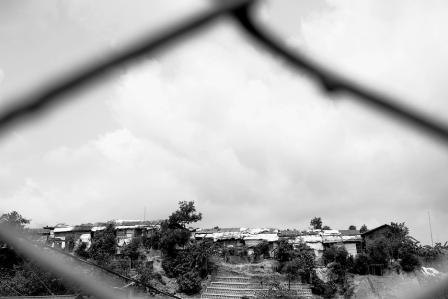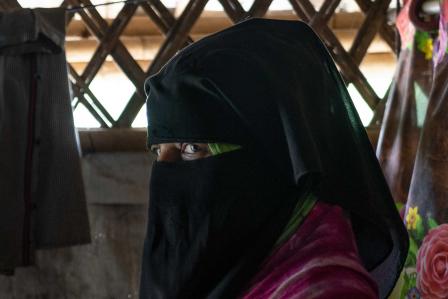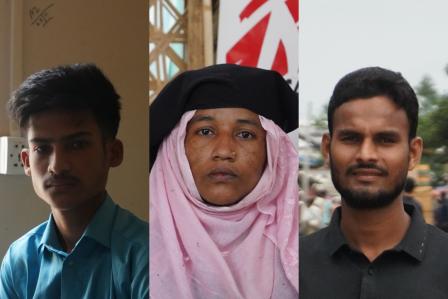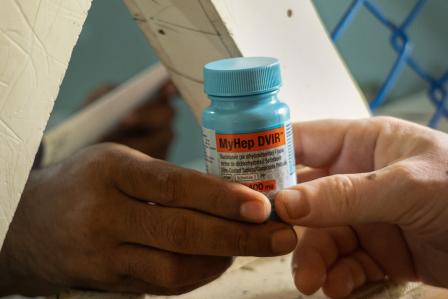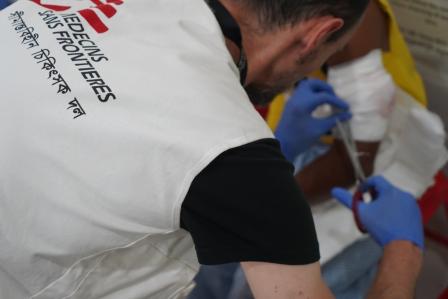Rohingya: Two crows, a banyan tree, and leaving a trace for the future
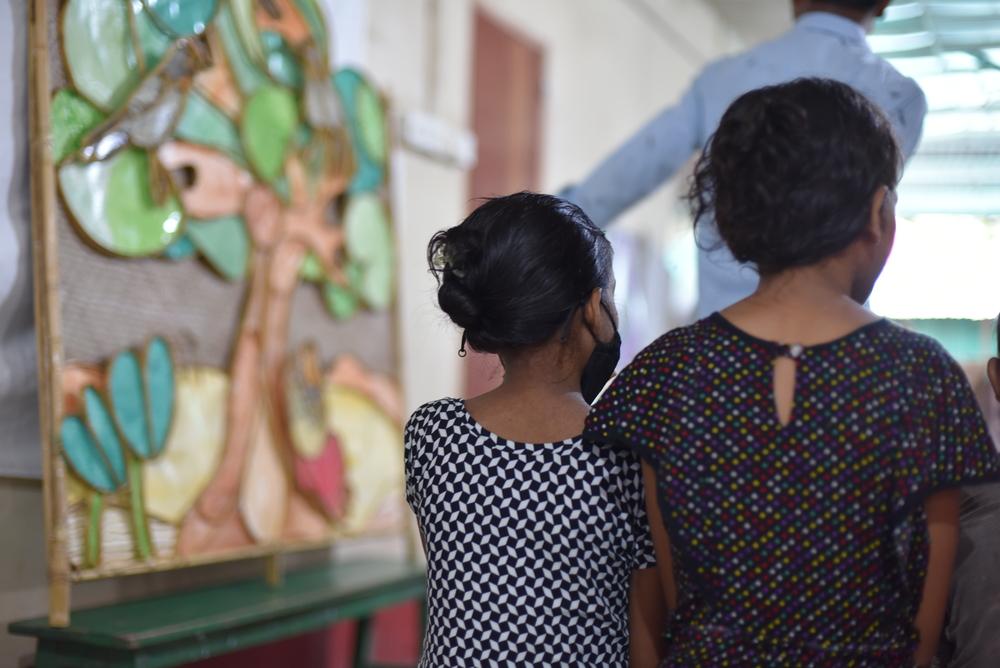
A group of young patients, their families and Doctors Without Borders staff gather in the outpatient department of the Doctors Without Borders Kutupalong hospital for the first kyssa storytelling session with the story panel and Mohammed Rezuwan Khan, Rohingya storyteller.
© Victor Caringal/MSF
In the world’s largest refugee camp in Cox’s Bazar, Bangladesh, Doctors Without Borders / Médecins Sans Frontières(MSF) is partnering with a Rohingya community to bear witness to the challenges, experiences and survival of Rohingya people.
Laid out on a wooden panel in the backyard of a Doctors Without Borders health facility in Kutupalong refugee camp, Cox’s Bazar, Bangladesh, a bamboo-cane tree is taking shape.
Busy hands work away at the tree, as health staff move between the buildings and banana palms in the background. Around the tree, a group of makers pass bamboo weaving strips between them. They turn the strips on their side, layer and bend them into smooth curves, then bind them together with thinner strips.
The form of the tree swells. It is puffy, cloud-like, brimming with the possibility of shade for a person who might sit underneath it. It is a banyan—a type of tree well known to Nurus Safar and Nuru Salam, two of the makers and Rohingya weavers.
During a break in the heat, Nurus Safar and Nuru Salam sit together with one of their co-makers, social designer, Tasman Munro.
“When we used to work under the banyan tree and chat, many people could gather, and we could teach others and share the feeling,” says Nurus Safar, reminiscing about weaving back in Myanmar, in the time before they came to Bangladesh. “We could enjoy making there.”
Today, while Nurus Safar and Nuru Salam are many kilometres away from their home in Myanmar, the banyan tree is once more providing a place for gathering, teaching and sharing Rohingya culture.
Back at work, the makers begin adding colourful paper panels to the cane tree. The panels were designed by young Rohingya artists the day before, as they listened to a storyteller recount a kyssa (a traditional Rohingya folktale).
Slowly, the bright cane-and-paper scene forms: the banyan tree, two crows, a Rohingya woman and taro leaves. It is a kyssa story-panel; a gift to share with young Rohingya patients in Doctors Without Borders' care.
“Separating little by little”
“The story we are going to make, with the crow and the banyan tree, it will make us lighter of feeling… reminding us, and connecting us with our heart to the land,” says Ruhul, a Rohingya community member and Doctors Without Borders staff member in the Cox’s Bazar camps. “That [connection] is separating little by little, particularly for the young generation.”
For Ruhul, the increasing separation of his people from their land and home is front of mind, as this Rohingya community mark six years since they were forced out of Rakhine state (Arakan), Myanmar, into the Bangladesh camps by a violent Myanmar military campaign.
The 25 August 2017 displacement was not the first for the Rohingya, who were made stateless in 1982 and have experienced decades of persecution and targeted violence in Myanmar, while facing discrimination and exclusion in the countries where they seek safety.
Ruhul compares the situation of the Rohingya to the proverb of water off a taro leaf. No matter how water falls on a taro leaf, it will leave no trace. “We have been living in Myanmar since hundreds of years back; when we [were driven] away, no mark remains. We are like a floating people—the taro leaf is something [that makes] us remember our situation.”
In the Cox’s Bazar camps, at least one million Rohingya refugees are currently facing a crisis health situation, are unable to gain proper education, and are not allowed to work. As time ticks by, and their future remains uncertain, many Rohingya are focused on retaining their culture and identity for the younger generations.
Yakub, the storyteller who shared the kyssa for the young artists to form the basis of the story-panel, agrees. “Our culture is disappearing,” he says. “That is why it is important to teach our culture to the young generation. When I start to tell kyssa, I see the children happy and smiling. I can’t help the bigger picture, but I can at least do a small thing to maintain our culture.”

In June 2023, Doctors Without Borders together with a social designer collaborated with Rohingya storytellers, young artists and bamboo weavers in Kutupalong refugee camp. Together, they created a story-panel illustrating traditional kyssa (folktales), to share Rohingya culture and messages with young patients and families in Doctors Without Borders’ clinics, and to the world, marking six years since the mass exodus of Rohingya from Myanmar.
© Victor Caringal/MSF
In partnership for the community
In early August, young patients, their families and Doctors Without Borders staff in the Doctors Without Borders Kutupalong hospital gather for the first kyssa storytelling session with the story-panel. A group of small children crowd close to the banyan tree and crows in the front row, as the storyteller, Mohammed Rezuwan Khan, begins.
As Rezuwan speaks in Rohingya, the children call back. There is some confusion, lots of movement, laughter and smiles.
Afterwards, Doctors Without Borders head of mission in Bangladesh, Arunn Jegan, shares his impressions. “It was so important to see our Rohingya colleagues share their culture and kyssa. Too often Rohingya people are stereotyped as vulnerable—as patients, or as stateless people who do not have the legal right to exist freely in Myanmar, or as refugees.
“Today, we got to celebrate the Rohingya as a people, through their culture. Joyful moments that focus on self-value are therapeutic for Rohingya patients, some of whom are coping with difficult mental health conditions, and in the lead up to 25 August.”
For Tasman Munro, the partnership created between everyone involved in the project has gone some way to redefining those stereotypes: “Rohingya people have had a lot of stories placed upon them. Co-design creates a process for them to create the stories they want to be defined by.”
Ruhul is certain about this story.
“Even though we suffer for five decades, we are still resilient. Even though our land was confiscated, we are still strong enough to survive.”
*Some last names have been withheld for privacy.


